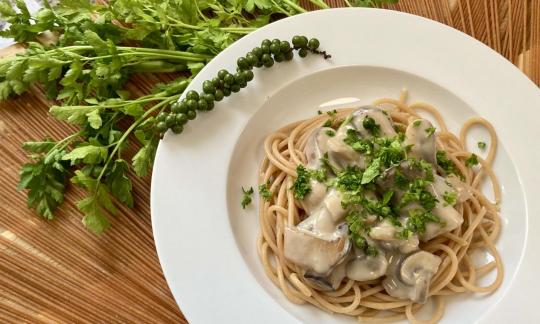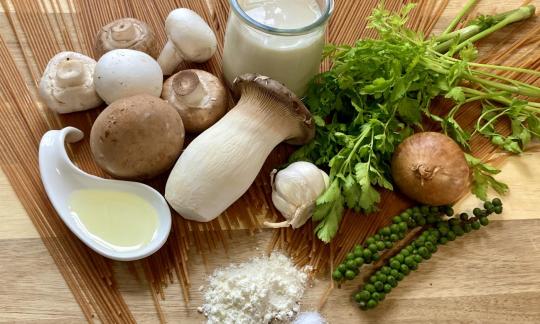Spaghetti mushroom pan with fresh green pepper
vegan
Ingredients (for servings, )
| For the basis | |
|---|---|
| 11 oz | Whole grain spaghetti, vegan (organic?) |
| For the vegetables | |
| 1 | Onions, raw (organic?) (3.9 oz) |
| 2 cloves | Garlic (organic?) (0.21 oz) |
| 4 ½ oz | Raw king oyster mushrooms (organic?) |
| 16 oz | Cultivated mushrooms, raw (organic?) |
| 1 tbsp | Rapeseed oil, refined (organic?) (0.49 oz) |
| For the sauce | |
| 1 ½ tbsp | Rapeseed oil, refined (organic?) (0.74 oz) |
| 1 ½ tbsp | Wheat flour (raw?, organic?) (0.53 oz) |
| 200 ml | Oat milk (oat drink, raw?, organic?) (7.0 oz) |
| ⅓ oz | Green pepper (organic?, raw?) |
| ½ tsp | Table salt (table salt, raw?, organic?) (0.11 oz) |
| Topping | |
| 1 ⅜ oz | Parsley, fresh, raw (leaf parsley, parsley) |
Equipment
- whisk
- skillet (frying pan)
- stove
- saucepan
- sieve
Type of preparation
- cook
- chop or grind
- sweat
- deglaze
- remove the skin
- drain
Preparation
For the wholemeal spaghetti
Put a large pot of lightly salted water on the boil. As soon as the water boils, add the spaghetti, stir and cook according to the instructions on the packet for about 10 minutes. Then drain.During the cooking process, start with the next preparation step.
For the vegetables
Peel and finely chop the onion and garlic. Clean the mushrooms. Cut the oyster mushrooms into small cubes. Cut the mushrooms into slices depending on their size or cut them in half.
Heat the oil in a pan. Add the onions and sauté for about 2 minutes. Then add the mushrooms and garlic and sauté for about 5 minutes. Stir occasionally. If it starts to stick, you can add 1-2 tablespoons of water. Then remove the pan from the heat and continue with the next step.For the sauce
Heat the oil in a pan. Add the flour and stir well. Gradually add the oat milk, stirring constantly with a whisk. Add the green pepper and let the sauce simmer for a few minutes. Season with salt or alternatively stock powder. Then mix the sauce with the mushrooms.If lumps form, you can pour the sauce into a measuring cup and stir it with an electric whisk until smooth (before adding the mushrooms).
Completing the dish
Arrange the spaghetti on plates and pour the sauce over it. Serve sprinkled with chopped parsley.
|
Nutritional Information per person
Convert per 100g
|
2000 kcal | |
|---|---|---|
| Energy | 452 kcal | 22.6% |
| Fat/Lipids | 13 g | 17.9% |
| Saturated Fats | 1.2 g | 6.1% |
| Carbohydrates (inc.dietary fiber) | 76 g | 28.0% |
| Sugars | 8.7 g | 9.6% |
| Fiber | 11 g | 43.7% |
| Protein/Albumin | 17 g | 34.7% |
| Cooking Salt (Na:340.7 mg) | 865 mg | 36.1% |
| Essential micronutrients with the highest proportions | per person | 2000 kcal | |
|---|---|---|---|
| Min | Manganese, Mn | 3.0 mg | 152.0% |
| Min | Selenium, Se | 75 µg | 135.0% |
| Prot | Tryptophan (Trp, W) | 0.22 g | 90.0% |
| Min | Copper, Cu | 0.89 mg | 89.0% |
| Vit | Vitamin K | 65 µg | 86.0% |
| Vit | Vitamin B3 (Niacin) | 13 mg | 81.0% |
| Elem | Phosphorus, P | 414 mg | 59.0% |
| Prot | Threonine (Thr, T, irreversibly transaminated) | 0.53 g | 57.0% |
| Prot | Valin (Val, V) | 0.90 g | 56.0% |
| Vit | Vitamin B9, B11 (Folate, as the active form of folic acid) | 111 µg | 55.0% |
Detailed Nutritional Information per Person for this Recipe
The majority of the nutritional information comes from the USDA (US Department of Agriculture). This means that the information for natural products is often incomplete or only given within broader categories, whereas in most cases products made from these have more complete information displayed.
If we take flaxseed, for example, the important essential amino acid ALA (omega-3) is only included in an overarching category whereas for flaxseed oil ALA is listed specifically. In time, we will be able to change this, but it will require a lot of work. An “i” appears behind ingredients that have been adjusted and an explanation appears when you hover over this symbol.
For Erb Muesli, the original calculations resulted in 48 % of the daily requirement of ALA — but with the correction, we see that the muesli actually covers >100 % of the necessary recommendation for the omega-3 fatty acid ALA. Our goal is to eventually be able to compare the nutritional value of our recipes with those that are used in conventional western lifestyles.
| Essential fatty acids | per person | 2000 kcal |
|---|---|---|
| Alpha-Linolenic acid; ALA; 18:3 omega-3 | 0.88 g | 44.0% |
| Linoleic acid; LA; 18:2 omega-6 | 3.1 g | 31.0% |
| Essential amino acids | per person | 2000 kcal |
|---|---|---|
| Tryptophan (Trp, W) | 0.22 g | 90.0% |
| Threonine (Thr, T, irreversibly transaminated) | 0.53 g | 57.0% |
| Valin (Val, V) | 0.90 g | 56.0% |
| Isoleucine (Ile, I) | 0.64 g | 52.0% |
| Phenylalanine (Phe, F) | 0.79 g | 51.0% |
| Leucine (Leu, L) | 1.1 g | 46.0% |
| Methionine (Met, M) | 0.26 g | 28.0% |
| Lysine (Lys, K, irreversibly transaminated) | 0.50 g | 27.0% |
| Vitamins | per person | 2000 kcal |
|---|---|---|
| Vitamin K | 65 µg | 86.0% |
| Vitamin B3 (Niacin) | 13 mg | 81.0% |
| Vitamin B9, B11 (Folate, as the active form of folic acid) | 111 µg | 55.0% |
| Vitamin B2 (Riboflavin) | 0.75 mg | 54.0% |
| Vitamin B7 (Biotin, ex vitamin H) | 25 µg | 50.0% |
| Vitamin B1 (Thiamine) | 0.50 mg | 45.0% |
| Vitamin B5 (Pantothenic acid) | 2.6 mg | 43.0% |
| Vitamin B6 (pyridoxine) | 0.50 mg | 35.0% |
| Vitamin E, as a-TEs | 3.6 mg | 30.0% |
| Vitamin C (ascorbic acid) | 18 mg | 23.0% |
| Vitamin A, as RAE | 67 µg | 8.0% |
| Vitamin D | 0.22 µg | 5.0% |
| Vitamin B12 (Cobalamin) | 0.04 µg | 2.0% |
| Essential macroelements (macronutrients) | per person | 2000 kcal |
|---|---|---|
| Phosphorus, P | 414 mg | 59.0% |
| Potassium, K | 1'000 mg | 50.0% |
| Sodium, Na | 341 mg | 43.0% |
| Magnesium, Mg | 139 mg | 37.0% |
| Calcium, Ca | 70 mg | 9.0% |
| Essential trace elements (micronutrients) | per person | 2000 kcal |
|---|---|---|
| Manganese, Mn | 3.0 mg | 152.0% |
| Selenium, Se | 75 µg | 135.0% |
| Copper, Cu | 0.89 mg | 89.0% |
| Iron, Fe | 5.2 mg | 37.0% |
| Zinc, Zn | 3.7 mg | 37.0% |
| Iod, I (Jod, J) | 24 µg | 16.0% |
| Fluorine, F | 1.9 µg | < 0.1% |
The mixed mushroom pan with fresh green pepper and whole wheat spaghetti is wonderfully creamy - and it doesn't require any cream.
Nutrient profile: One portion of this high-fiber dish covers over 100% of the average daily requirement of manganese and selenium. Copper and the essential amino acid tryptophan are covered by 90%. The ratio of omega-6 to omega-3 fatty acids is 5:1, within the maximum recommended ratio. More on this at: Vegans often eat unhealthily. Avoidable nutritional errors.
Wholemeal spaghetti: Wholemeal spaghetti is usually made from wholemeal durum wheat flour mixed with water and salt, and more and more suppliers are also offering organic quality. In general, eating wholemeal pasta, unlike normal pasta, with its high fiber content helps reduce blood pressure, cholesterol levels, the risk of colon cancer, coronary heart disease and type 2 diabetes. In addition to the fiber, wholemeal products are healthy due to the antioxidants they contain.
Oyster mushrooms: The oyster mushrooms (Pleurotus), also known as king oyster mushrooms or king oyster mushrooms, are a genus of mushrooms from the family of the oyster mushrooms. Oyster mushrooms have a delicate aroma. The oyster mushrooms are available in brown or pale colors, with the flesh of the brown oyster mushroom having a porcini-like consistency. The aroma of the oyster mushroom is also similar to that of the porcini mushroom. It is also cultivated. Like the button or porcini mushroom, it can also be eaten raw.
Mushrooms: The button mushroom is the most common cultivated mushroom. The flesh of the round mushroom is white and firm, the taste is mild. The brown button mushroom is a special variety that is less sensitive to pressure and has a more intense flavor than the white mushroom.
Green pepper: Green pepper is unripe peppercorns that have a very mild taste. Green peppercorns are harvested before they are fully ripe. Green peppercorns therefore have a fresher and less spicy aroma compared to black or white peppercorns. Its taste can be slightly fruity or floral.
Oat milk: Oat milk (EU: oat drink) is made from oats and water. Oat milk is suitable as a cow's milk substitute and is easy to prepare yourself (see "Alternative preparation").
Parsley: Parsley is a source of flavonoids, antioxidants and vitamins, especially vitamins K, C and A, which makes this culinary herb suitable for more than just a garnish. There is curly leaf parsley, root parsley and flat-leaf parsley. The latter is considered spicier than the curly leaf parsley and root parsley is the strongest in taste. All parts of the parsley plant have a strong, spicy-bitter aroma, although the often less noticed stems are particularly aromatic.
Amount of salt and oil: We have deliberately reduced the amount of oil for health reasons. We have not given any information on the amount of salt, as individual needs vary greatly. It is up to you to decide, but we recommend keeping the salt content as low as possible. It takes around 3 months to get used to a lower salt content, but you will also benefit from this change in terms of taste. You can find more information on this topic in the book we describe in detail: Salt Sugar Fat by Michael Moss.
Buy green pepper: Fresh green pepper is available in well-stocked supermarkets or in Asian supermarkets.
Whole wheat pasta: You can use whole wheat linguine or whole wheat macaroni instead of the whole wheat spaghetti listed.
Mushrooms: You can also use other mushrooms, such as chanterelles or just button mushrooms .
Making oat milk: Information on making your own raw vegan oat milk can be found under the "Make Your Own" section in the following link: Oat milk.






